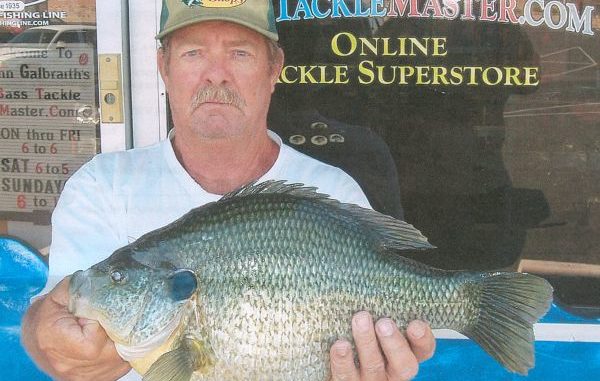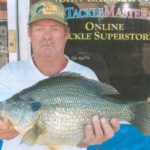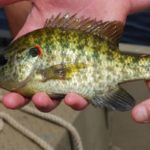
A prince among perch
Yes, I know that a redear sunfish isn’t really a perch, but that along with “bream” is the generic name for the clan of freshwater panfish that includes bluegills, goggle-eyes, slick perch (green sunfish), sunperch and stumpknockers.
Of these six species, the redear sunfish — usually either called a chinquapin or a lake runner — is probably the most prized by Louisiana bream fishermen.
It doesn’t form spawning beds as large as those of bluegills, and its spawning season is much shorter.
It is a picky eater. It never rises to take surface poppers, and even turns its nose up a little at crickets — both of which are cocaine to a bluegill.
It isn’t as chunky as a goggle-eye. It isn’t as pretty as a sunperch.
But it is heftier, length for length, than are bluegills because of its thick body. For a short four to six weeks each spring, it does form sizable spawning beds that allow a lot of fish to be caught from a small area.
It tastes better (arguably) than a goggle-eye. If you give it what it wants to eat, it’s a dead sucker for a baited hook.
It is a lot bigger than a sunperch, which makes up for its relatively drab color.
Redear sunfish are named for the red-margined black flap that extends rearward from each gill cover. Where the nicknames chinquapin and lake runner come from beats me.
From Alabama eastward they are called “shellcrackers” because they are supposed to love to eat snails.
I learned about this habit as a grade-school kid. I never did figure out how to catch enough snails to catch a mess of fish, and what snails I did get I never could figure out how to keep them on a hook.
Try it — you’ll see. At the touch of a hook, a snail’s shell disintegrates, and all you have then is a blob of snot.
The origin of the redear’s scientific name, Lepomis microlophus, is easier. It’s all Greek; no Latin. “Lepis” means “scaled” and “poma” means “gill cover.” The second part of the name “microlophus” means “small nape.”
Of course, understanding the name’s origin has little to do with why a scientist would tag it with the name it has. Lots of fish have totally or partially scaled gill covers. As for being “small-naped,” our guy here has a thicker “neck” than any of the other bream except for the goggle-eye.
Whatever you call it, this fish is definitely a fish of the South, covering all the states of the old Confederate States of America (except Virginia) like a blanket. Throw in parts of the border states of Kentucky and Missouri, the Yankee state of Illinois and the Indian state of Oklahoma, and you have its range.
Wherever it is found it seems to prefer the sluggish waters of bayous or the still waters of stream or river backwaters and lakes. It does particularly well when stocked in bass/bluegill ponds as a third species.
Of all the bream species, this one has the most tolerance for salt and can be found in salinities of 4 or 5 parts per thousand. For comparison, full-strength seawater is 35 ppt.
For as far back as anyone can remember and lasting up until Hurricane Katrina, a vigorous redear (there, they were always called lake runners) fishery existed south of Lake Pontchartrain in Bayou Savauge and surrounding waters.
One of the mysteries of the fish is that, while it’s not found everywhere, where it is found it can occur in large numbers. Most of those numbers are caught during their spring spawning season that overlaps parts of March and April in Louisiana.
Spring is a magical time for bream fishermen who like redears (and they all do). Redears are the first bream species to spawn each year. Males congregate in areas of their choosing to build nests. Nesting colonies are built on varying bottom types, from sand to soft mud, but often aquatic plants are present. Redear nests have been found in waters as shallow as 18 inches and as deep as 10 feet.
Males use their tails to sweep a saucer-shaped depression into the bottom. In dense colonies, these nests might be almost touching each other. Each male defends his nest as his territory against intruders. Spawning begins at water temperatures of about 68 degrees Fahrenheit.
Some scientific reports indicate that males court females that approach their nest by making popping noises with their jaws near the female’s head and sides.
Once a female decides on a male, she will favor him with from 2,000 to 64,000 eggs, depending on her size.
The male fertilizes and guards the eggs and then the larvae for about a week after they hatch.
Young redear sunfish grow quickly and can reach sexual maturity at age 1. Most do not spawn at that age, though, because of competition from older and larger males. Redear sunfish live to at least 4 years old.
At least one scientific reference reports that male redears do not feed during the period when they are courting and defending the nest area. This is a huge surprise to bream fishermen, who wait all year to make big catches of redears on their spawning beds.
Redear sunfish are primarily bottom feeders and have been observed swimming head-down into the bottom raising clouds of sediment. Favored foods (besides snails) include the larvae of insects like midges, mayflies and dragonflies and small crustaceans such as amphipods. Ideal live baits for this fish are grass shrimp or earthworms.
Redears grow to respectable sizes. The Louisiana state record is 2.87 pounds, and was caught from Caney Lake in August 1998 by Jerry Smelly. The Louisiana Outdoor Writers Association recognized that fish as “Fish of the Year.”
Eight of the current top 10 redears in Louisiana came from Caney Lake.
The IGFA world-record redear sunfish was caught in Lake Havasu, Ariz., by Robert Lawler in May 2011. That mammoth fish weighed 5 pounds, 8 ounces.




